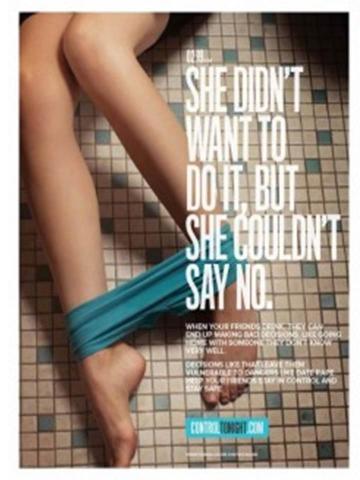
"There is no vulnerability without danger.” Veronique Valliere, Psy.D.
Our society blames women (and men) who are sexually assaulted, particularly when their choices leading up to the attack make them, in most minds, “more vulnerable.” Like when they drink too much, or when they go home with a man they don’t know well. And so on.
The ad above from the Pennsylvania Liquor Control Board sparked a debate in feminist circles. The ad itself wasn’t the issue; most agreed it was offensive. Visually it sexualized violence, right down to the blue underwear around the seductively placed ankles matching the tile on the floor. That’s not a representation of the aftermath of a felony. It’s wanna-be pornography. And of course, it callously blames the girl for not preventing the rape she apparently endured. No mention of the rapist.
It is the underlying message that begs a question: Shouldn’t we warn girls and women about the dangers of losing control, and thus “becoming vulnerable?” Isn’t it simply a dangerous world, like it or not? Vulnerability invites danger. Right?
Wrong.
Go back to the statement at the top of the page. Vulnerability does not exist unless danger is present. Choices, however reckless as they may appear, do not create danger any more than liquor creates rape in a man who is not a rapist. Danger exists because of the choices dangerous people- rapists, in this case- make. From this reality, two others flow: First, encouraging young people to avoid victimization through more responsible behavior will not prevent a single rape. Rape is never an accident, and it’s almost always a planned attack. The rapist who cannot target a“better-behaved” woman will find one who isn’t. So there won’t be less rape, just rape of perhaps different people.
The woman who believes she is safer because she’s avoiding something like heavy drinking might well be safer to a particular kind of attack. But there are many others, and being lulled into a false sense of security because of the avoidance of one behavior will likely blind her to the danger that can exist under the most responsible appearing of circumstances. Women are raped by trusted friends. They’re raped during the daytime while studying or just listening to music with known, clean-cut, well-regarded men in their communities, on their campuses, from their churches. Alcohol is extremely helpful to acquaintance rapists. But it is hardly their only tool.
Youth involves blind spots, but regardless of age, risk-taking is the essence of life. There is no elimination of it short of solitary confinement. What we must do is grasp that vulnerability exists only when danger is present, and turn the focus rightly on the dangerous and away from the endangered.
Because when we create rules, particularly ones laced with moral superiority in order to somehow deliver us from evil, we then distance ourselves from those who break them. When those people are victimized, we rest easy, believing that our wisdom and temperance saved us. But there are always more rules, both to make and to break. In the end, all that rule making accomplishes is the encouragement of an insidious urge to will to life something other than luck separating us from the unlucky. So we’ll draw attention to the choices the rule breakers made that we wouldn’t make. And we’ll blame them for theirs.
Veronique Valliere, Psy.D., has more than 25 years of field experience as a clinical psychologist. She puts this experience to work training law enforcement personnel to see beyond bias, stereotypes, and misinformation so they are not manipulated by those who commit violent and sexual assaults.
In her Talk, "Sexual Assault and the 'V' Word," (Please click here to view it) Valliere provides a paradigm shift for understanding interpersonal violence and the role the observer or audience plays in the offender's success or defeat. The "V" word may not be the one you expected, but it is the key to preventing assaults of all types.

Comments
Hello, after reading this
Hello, after reading this remarkable post i am too delighted to share my knowledge
here with colleagues.
Add new comment